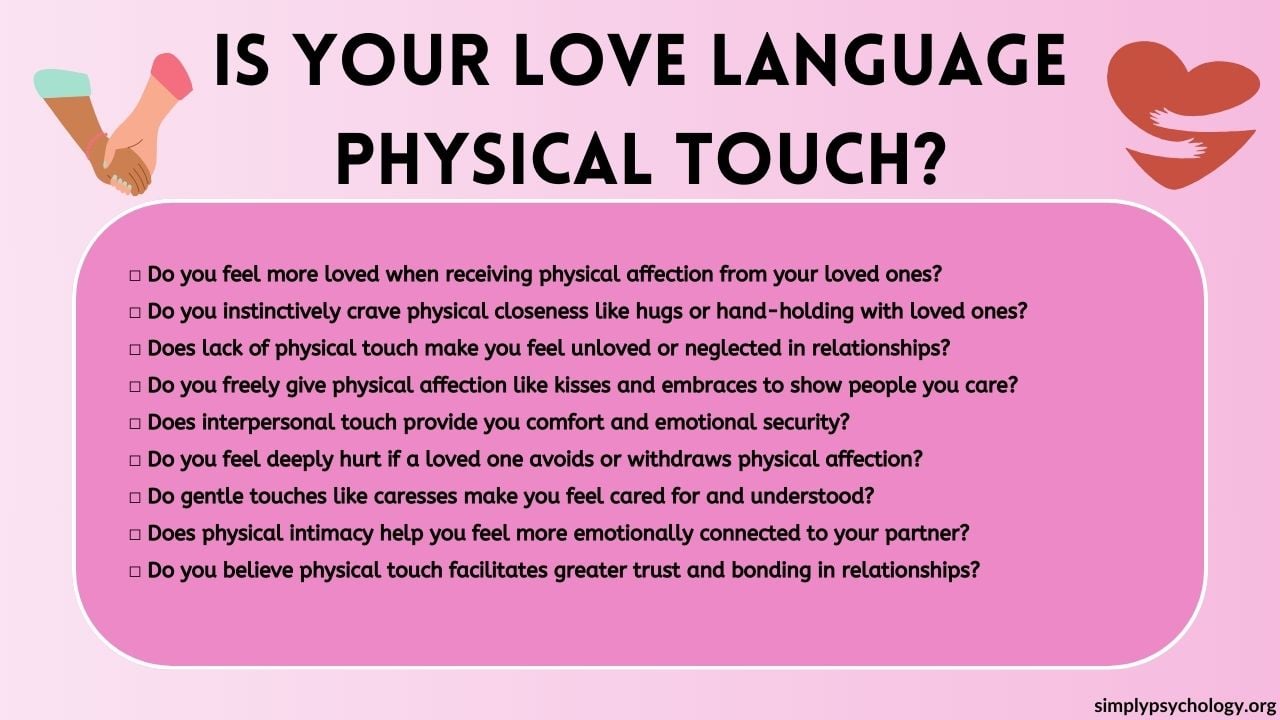The physical touch love language emphasizes expressing and receiving love through physical gestures like hugging, holding hands, and cuddling, signifying closeness, comfort, and emotional connection for individuals who prioritize this form of affection.
Dr. Chapman is a psychologist-anthropologist and the author of the book “The Five Love Languages,” published in 1992.
Love languages, as a concept, describe the way someone expresses and receives love (Chapman, 1992). Physical touch specifically refers to people who either feel loved or express love the best by being physically affectionate with their partners and loved ones (Chapman & Chapman, 2010).

Such physical affection can range from simple acts like cuddling or holding hands when walking/sitting together to gentle caresses whenever you are in close proximity. Through such touches, emotions of connection, partnerships, and love can be fostered.
“It’s like how people say they want to feel closer to someone emotionally, except I feel emotionally close to someone when I’m physically close to them. Sometimes, that’s long hugs.”
‘Marjorie’
Similarly, for people with this love language, it can be extra hurtful when their partner or loved ones avoid being physically affectionate with them, which can lead to emotions of neglect and unwantedness.
Physical touch is not gender or age-specific (Chapman & Campbell, 2008); anyone can have a preference or disinclination for it, which can also change over time as it is not a rigid concept.
How do you know if your love language is physical touch?
One of the easiest ways to determine your primary love language is by taking the free quiz developed by Dr. Chapman himself (available on the five love language website). It will ask you a series of questions to help you reflect on your preferences and what is most meaningful to you.
Additionally, there are a few things you can reflect on yourself to help you decide if physical touch is your love language. You could ask yourself the following questions:
- Do you feel more loved when you receive physical affection from someone you love or care about?
- Do you tend to find yourself craving physical closeness, such as holding hands, kissing, hugging, etc., whenever you are close to someone you love?
- If there is ever a lack or very minimal physical touch in your relationships, do you tend to feel more neglected or unloved?
If you answered mainly yes to these questions, then physical touch is likely one of your primary love languages. This means that you feel connected and cared for in your relationships when there are frequent acts of physical affection.
Many people unconsciously use their preferred love language to showcase their emotions to someone, as that is how expressing care comes the most naturally to them. Hence, you may also be someone who enjoys giving physical affection to others.
For example, you may be someone who instinctively hugs your friends and family when you see them, hold your partner’s hand whenever you are in close proximity or enjoy giving kisses to those you care about.

How to show physical touch love language with your partner

If your partner has physical touch as their love language, then it is important to incorporate acts of physical affection into your weekly routine. This will ensure that you are showcasing your love in a manner your partner understands and receives the best.
General principles
There are a few general principles to keep in mind when it comes to showing a partner love in this way.
Having this love language means that your partner enjoys acts of physical touch and any gestures that reflect your care in a more “skin-to-skin” manner. For them, this close proximity between you directly reflects your emotional proximity.
The closer and more frequently that you engage in physical touch, the more secure, loved, and emotionally connected they can then feel toward you. Think of it as the physical manifestation of your positive feelings towards them.
Physical touch love language examples
Some examples of showing someone love and affection through physical touch are:
- Holding hands. This could be when you are out and about, sitting at home, or during any shared activities.
- Hugging. Embrace them often. Make sure to really linger close and take your time enjoying the hug. You could even come up from behind and wrap your arms around them.
- Kissing. A classic for a reason, ensure you kiss them frequently, especially before leaving. This does not have to be just on the lips; you can kiss other parts of their face, such as cheeks and eyebrows.
- Sitting close together. You can further enhance this by laying your hand across their shoulder or leg.
- Cuddling or snuggling. Whether you are in bed, watching a movie, or spending some quality time alone, ensure you give them lots of cuddles. You can lay your head on top of theirs and interlock hands as well.
- Resting your hand on them, e.g., on their shoulder or arm. This could be a nice subtle way to keep physical contact with your partner when you are in public, out with friends, or in a larger get-together.
- Dancing. This could be in the privacy of your home if either of you is shyer. You could also suggest taking lessons together.
- Playing with their hair. Gently comb their hair or twirl strands with your fingers. Make sure you do not tug too hard.
- Massages. Gently rub their shoulders, legs, feet, etc., especially if your partner has had a long day or is feeling stressed.
- Sexual intimacy. Ensure you are initiating sex and not just leaving it up to your partner, and take the time to learn their preferences and desires in the bedroom.
Physical intimacy vs. sexual intimacy
It is essential to mention the difference between physical intimacy and sexual intimacy.
Due to the nature of physical touch, it can be easily assumed that this includes sexual intimacy. That can most definitely be the case but not always. Everyone has their own preferences and ways they feel the most loved.
For some, physical touch can translate into more soothing touches like gentle strokes, cuddles, or caresses. It is thus essential to maintain open and honest communication with your partner at all times to ensure your actions genuinely reflect each other’s needs.
How important is physical touch in a relationship?
Physical touch is an integral part of a relationship as it allows couples to get emotionally closer, share intimacy and ultimately express their love for each other. This can be especially true for people that have physical touch as either their primary love language or within their top two.
Looking at the research evidence, couples that were more engaged in interpersonal touch reported overall higher levels of physiological and emotional well-being than participating couples who had less physical contact with their partners (Debrot, Schoebi, Perrez & Horn, 2013).
Physical affection can also have a foundational role in developmental attachment and our ability to form intimate bonds in close relationships, as well as in trust development (Collins & Feeney, 2004).
Stress levels are another factor directly related to the levels and frequency of physical affection.
Evidence depicts lower levels of various stress-related measures, such as cortisol and blood pressure, for couples that engaged in more physical affection between them (Holt-Lunstad, Birmingham & Light, 2008).
This further emphasizes the importance of physical touch in maintaining relaxed and more satisfactory relationships.
However, it is again important to highlight that despite the general overall benefits of physical touch, each person is unique in their preferences.
Consent should be maintained at all times to ensure everyone’s comfort levels and boundaries are respected.
Always ensure open communication before engaging in any form of physical contact, and never pressure anyone into acts of physical intimacy.
How to express physical touch in long-distance relationships

Despite the lack of proximity, you can still express physical touch in a long-distance relationship.
This will not be the same, of course, as having your partner next to you, but there are still ways to create a sense of physical affection and care.
Try incorporating video chats throughout your week so you can have designated time in both of your schedules to connect with each other. When on camera, you can blow kisses or reach out toward the screen to emulate a hug.
You can also send gifts or care packages. This is a wonderful way to show your partner love with an assortment of items you have hand-selected for them.
You can even include personal items such as an article of your clothing or even a stuffed animal and name it after yourself.
Lastly, play video games together. There are several online games where you can create your own avatars, and you can share more physical affection and proximity through the video game characters.
A man whose love language is physical touch explains how he responds when his partner expresses that they cannot wait to hug him (but has not initiated the physical touch yet):
“Just the thought of it is enough to elicit a physical response from me. It warms me inside and makes the hairs on my arm stand on end. It completely makes my day, especially at the end when the hug gets to happen.”
Frequently Asked Questions
What could you do if your love language is physical touch, but your partner’s isn’t?
If physical touch is one of your love languages, but it is not for your partner, there are a few things you can do to meet in the middle and express your love in a manner that feels natural to you both.
Firstly, have an open conversation about your preferences. You might discover that they might be averse to only certain types of physical affection but are okay with others. Ensure you are being open and specific about your needs.
Secondly, find a compromise and begin with small steps. You can mutually agree that, e.g., when watching a movie at home, you can cuddle for a bit.
Lastly, be patient and try adding some other love languages to supplement moments when your partner would not like physical touch.
Is physical touch a rare love language?
Physical touch is not a rare love language. In contrast, it is one of the most popular ones, with a lot of people self-identifying as having it in their top two love languages (Orth & Sanders, 2022).
That being said, it is essential to note that everyone is different. Just because two people may express or receive love this way does not automatically mean that they share and enjoy the same forms of physical affection.
There is no correct or incorrect way to show love with this love language; it just comes down to preferences and what fulfills someone’s needs.
How can you show physical touch love language with a friend or family member?
Physical touch is essential not only for romantic relationships but also platonic and family relationships as well.
Here are a few examples of how you can show the physical touch love language to your family and friends:
– Give them frequent hugs. This is a quick, easy, and powerful way to convey a lot of emotions through a simple act and really make you feel connected with the other person.
– Sit close to them. You can create a better environment of love and intimacy to foster that sense of togetherness. It also makes it easier to reach them e.g., pat their shoulder when laughing or talking.
– Link arms together. This could be when you are walking or taking a stroll, for example. Simple again, but very effective in bringing you closer.
What is important to consider when using this love language?
When using the physical touch love language, it is important to consider a few things.
Consent is critical; ensure you ask permission before you physically touch someone, especially if you do not know them very well.
Ensure that they remain comfortable and never push them beyond their boundaries.
Pay attention to their non-verbal cues, and if they look uncomfortable or withdraw to themselves, it could indicate a dislike of the physical touch level you are giving.
Additionally, consider your environment, as some people may be okay with physical touch in more private areas but feel uncomfortable with public displays of affection.
Lastly, never force or guilt someone into using or incorporating this love language. Everyone is unique in how they receive and understand love, so it is important to adjust approaches to ensure everyone’s comfort.
References
Chapman, G. D. (1992). The five love languages. Northfield Pub.
Chapman, G., & Campbell, R. (2008). The five love languages of children. Moody Publishers.
Chapman, G. D., & Chapman, G. (2010). The five love languages: The secret to love that lasts. Northfield Pub.
Collins, N. L., & Feeney, B. C. (2004). An attachment theory perspective on closeness and intimacy. In Handbook of closeness and intimacy (pp. 173-198). Psychology Press.
Debrot, A., Schoebi, D., Perrez, M., & Horn, A. B. (2013). Touch as an interpersonal emotion regulation process in couples’ daily lives: The mediating role of psychological intimacy. Personality and Social Psychology Bulletin, 39(10), 1373-1385.
Holt-Lunstad, J., Birmingham, W. A., & Light, K. C. (2008). Influence of a “warm touch” support enhancement intervention among married couples on ambulatory blood pressure, oxytocin, alpha amylase, and cortisol. Psychosomatic medicine, 70(9), 976-985.
Orth, T., & Sanders, L. (2022, February 11). What are Americans’ love languages? YouGovAmerica. https://today.yougov.com/topics/society/articles-reports/2022/02/11/what-are-americans-love-languages


